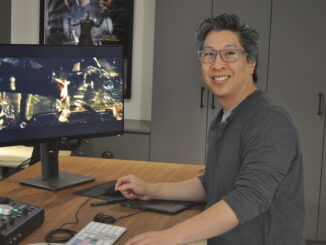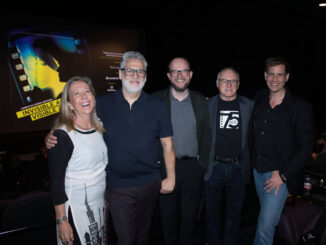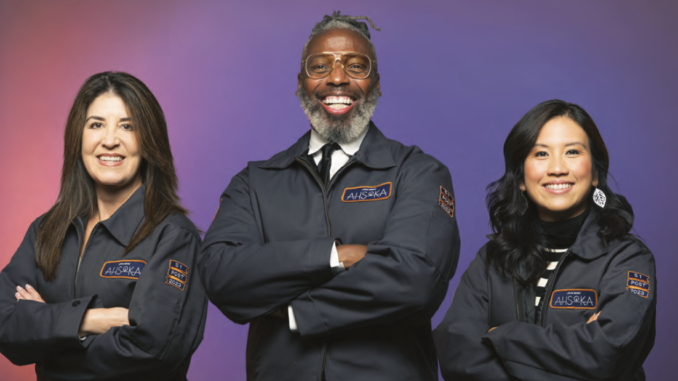
By A.J. Catoline
The latest Star Wars series “Ahsoka” premiered last summer on Disney+, and the very first shot begins with the classic “In a galaxy far, far away…” title floating in space. That visual anchors viewers to something familiar.
What comes next, however, is an entirely new vision from writer-director/showrunner Dave Filoni that is brought to the screen thanks to his collaboration with many talented craftspeople — especially the editors and a vast post-production team.
“I want honest feedback from the editors,” Filoni told CineMontage about his collaboration in the cutting room. “As much as I have planned, there is always potential, and I want them to be encouraged to find it. There is always the story you imagined it would be, and then there is the story that it is. These things are very similar, but sometimes if you hold onto things too tightly, you miss opportunities.”
Riding along with Filoni on the new starship “Ahsoka” is a picture editorial crew who worked together for the first time on this project. They are Dana E. Glauberman, ACE, who cut films like “Ghostbusters: Afterlife,” “Up In The Air,” and “Juno”; Rosanne Tan, ACE, who edited on projects like “Hawkeye,” “The Falcon and the Winter Soldier,” and “Mr. Robot”; and James D. Wilcox, ACE, a frequent collaborator with Ron Howard who cut “Genius: Einstein, Chapter One,” “Hillbilly Elegy,” and “Thirteen Lives.”
Theirs was a long journey in editorial that lasted more than 18 months. The editors started cutting well before a frame of footage was shot.
“Rosie, Dana, and James did a fantastic job,” said Filoni. “I truly enjoyed working with each of them. It was fun, it was challenging, it was Star Wars. I’m so proud of them and grateful for their time and talents. The Force will be with them, always.”
Cinemontage: What is it like editing a new live action adaptation of the Ahsoka series? Dana, you have worked with Dave Filoni before. How did you embark on this new journey?
Dana: I had previously worked with Dave Filoni and Jon Favreau on “The Mandalorian,” season 1, and “The Book of Boba Fett.” Collaborating with the two of them, as well as the rest of the crew, was an incredible experience. And working on “Ahsoka” was no different. One of the most challenging things about “Ahsoka” was the pressure to bring Dave’s vision to life, and to do it right.
James: When I was finishing up “13 Lives,” I got a call about “Ahsoka,” which was great because I was looking to get into the sci-fi fantasy action realm. Instantly, I felt pressure to bring myself up to speed with “Clone Wars” and “Rebels” because there’s such a large mythology and history of the character.
Rosanne: I’ve watched the “Star Wars” films in the past and recognize the famous characters, but didn’t know much beyond that. So coming into this big galaxy was both exciting and new to me.
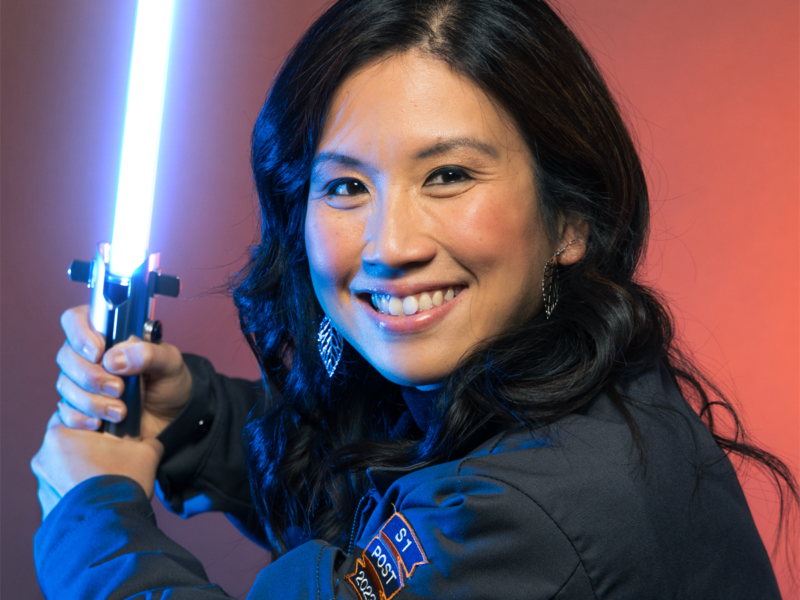
Cinemontage: And you all started early in pre-production?
Rosanne: Our process is unique because we were brought on much earlier than any other projects I’ve ever been on. We cut entire episodes with previz [pre-visualization] dailies, temp dialogue and with full sound design and music. And we did that many times over as we worked the changes with Dave, Jon, and the directors. And once we start production, the process starts over again since nothing is ever the same once it’s shot. The cuts were always evolving and improving.
James: Right from the beginning, there are big conversations about planning and execution: locations, stunts, shot design, camera coverage, and more, all of it regarding what parts of the story need previz. Very early on, we craft all these elements to get a sense as quickly as possible of what’s working before we move forward into production.
Dana: Before production even starts, we are editing a cut of each episode multiple times: first as a radio cut, where we guesstimate the pacing, which is hard to do without any visuals, but with dialogue only. We then finesse that radio cut with visuals provided by our previz team. And the usual process ensues after that.
Cinemontage: And how does it work when you are ready to show a cut to Dave Filoni and Jon Favreau?
James: When we’re in early edit sessions with Dave and Jon, it’s familiar territory going over story, character arcs, visual effects, pacing, and tone. What’s different and unique is that Dave is such a great artist, he can draw new story beats on the spot — and those illustrations are critical in determining what shots are needed to make a sequence work better.
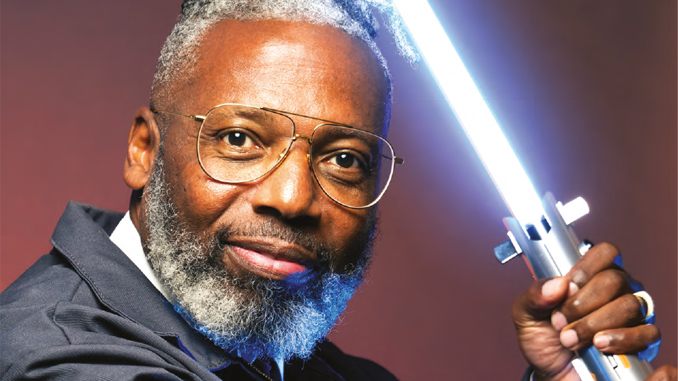
Rosanne: Dave and Jon know where they want the story to go. We’d try things, add/remove story beats or shots, work with visual effects, and make trims after trims. The whole process is very collaborative.
Dana: Dave has reviewed our previz cuts, so we already have a blue print of each episode. The speeder bike sequence with Sabine riding down the highway in the final version of episode 1 matches the previz cut pretty closely. We spent a lot of time on this sequence early in the process, and it might be one of the very few scenes in the whole series that stayed as close to the previz cut as it did.
Cinemontage: What makes Star Wars thrilling to watch is when you have intense action sequences that intercut with other action sequences. Is all that scripted or do you figure it out in editing?
Rosanne: Both. We always cut to script first so Dave can see what he envisioned. And we also try things in the room. For example, in episode 2, the big action intercuts — at the shipyard with Ahsoka (played by Rosario Dawson) and Marrok, and the transport chase with Hera (Mary Elizabeth Winstead) and Chopper — were different than what was scripted. While working in the room, we experimented and found different parts to intercut to make the whole sequence more exciting.
Dana: We added a lot of intercutting in both episode 1 and episode 4. In episode 1, we intercut shots of Ahsoka and [her droid] Huyang in the end sequence to help build the tension. Episode 4 had a lot of lightsaber fights, so we intercut between Ahsoka/Baylan fighting and Sabine/Shin fighting much more than what was scripted. Finding those right moments to intercut was challenging, but in the end, it all worked out with a wonderful balance.
Cinemontage: It might be every editor’s dream to cut a lightsaber duel. What’s that like?
Dana: It feels very much like a dance except the dancers are fighting with lightsabers. Having incredible actors who train hard for the part, fantastic stunt doubles, clear choreography, and beautifully shot footage helps the vision become apparent. That’s not to say we don’t use visual effects to speed things up, remove frames to make a hit look sharper, and apply other helpful tricks we learn along the way.
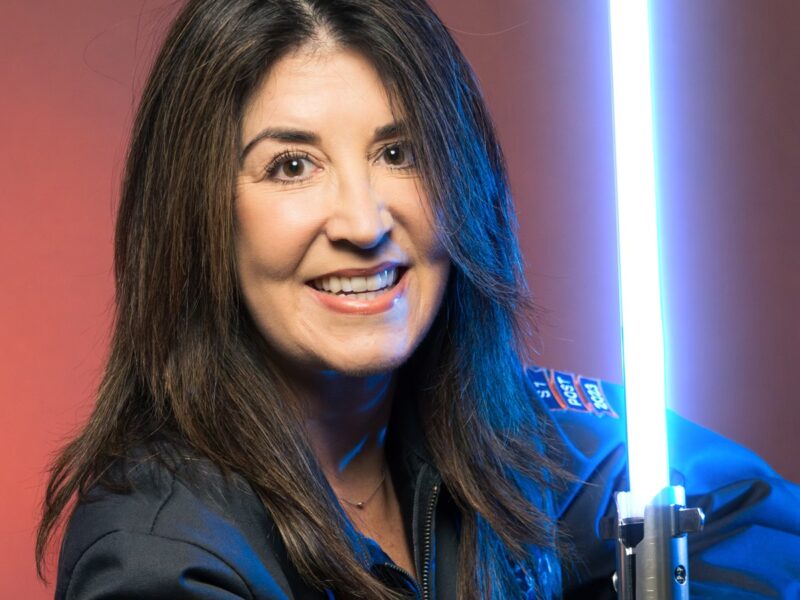
The lightsaber fights between the Jedi Masters are much different than that of their Padawans. For example, in episode 4, the Sabine/Shin lightsaber duels can sometimes feel like two kids fighting whereas the Ahsoka/Baylan duels are much more powerful. Baylan Skoll (played by the late Ray Stevenson) is such a huge force of nature, so the choreography is much more forceful. It creates different challenges in the editing, but it’s truly a joy to work on.
Rosanne: I’ve always had a great appreciation for martial arts, so cutting all the lightsaber duels was very exciting to me! I watch the dailies thoroughly before building the sequence. I do my best to elegantly weave the actors with the stunt performers and make sure every clash is thrilling and impactful. I lift frames and try other tricks to enhance the moves. Then I watch again before I hand over the sequence to my assistant editor, who starts to add the temp sound while I lay in the temp music. Then I fine tune yet again as I watch the duel come alive.
James: To sell the believability, I always favor the principal actor on camera because they’ve rehearsed so many times with our stunt coordinators and stunt doubles. They know the beats exactly, which helps me figure where the double is most likely to replace our principles. The rehearsals are recorded, which helps me know where the beats fall since I’m not on set. In episode 6, Sabine is on Peridea when she gets ambushed by bandits and has to take them out if she’s to find Ezra. I’d say 95% of that fight is Natasha, except for a few moments when she takes hard falls. When I first got the dailies, I didn’t realize she was so athletic and skilled as a saber-wielding fighter.
Cinemontage: How much temporary sound and music work do you add in your early cuts, knowing that eventually it all goes to sound editors and mixers at Skywalker Sound?
Dana: Skywalker Sound got involved very early during editing because we sometimes had the wrong lightsaber sounds, or we needed them to design something more specific that we didn’t have the capacity to do. As for music, we always add temp music, but Dave would definitely tell us if we were off base in terms of tone or what he was thinking and steer us in the right direction. Music can be so personal that it can be difficult to find temp music to fit exactly what the director/showrunner is thinking.
Rosanne: Every editor works differently. I believe having a cut with good sound design and temp music helps to build the tone and pacing. I always focus on the performances first until I have a good rough cut, before I lay in any kind of temp sound. For example, in episode 5, when Ahsoka falls through the clouds after encountering Anakin Skywalker (Hayden Christensen) in the World Between Worlds, we discover that it’s now the younger version of Ahsoka in a flashback. I experimented with adding reverb to the voices and adding and manipulating explosions, lasers, drone sounds, and the score. All of that helped with the tone of that scene and gave me a feel for when to stay longer on certain shots, etc. Ultimately, all our cuts provide a good starting point for the Skywalker team and our composer, Kevin Kiner, so they can go in and work their magic.
James: At the beginning of episode 6, we find Ahsoka and her droid Huyang riding in the belly of a Purgil (flying space whale) migrating across a new galaxy. Dave heard the scene with a temp cue and said “James, let’s try a version without the temp.” He didn’t mean play it dry, so I created a melody of whale groans and movements to get us into the scene and sometimes fill spaces in the dialogue. Everything I needed to sound-design the scene was in the Lucasfilm library. Typically, whale sounds have the ocean attached, but this is Star Wars, not your typical show.
Cinemontage: Tell us about your assistant editors and how, in the spirit of an apprentice training under a Jedi master, they collaborated with you in the edit?
Dana: My assistant, John Ott, is no stranger to the Star Wars Universe, so he was incredibly helpful with his feedback on my cuts early on, and we bounced ideas off of each other continuously. I’m kind of an old-school editor; I like to watch every frame of footage in every take so I can really focus on performance and story and try various ideas. After getting John’s stamp of approval, I would move onto another scene while he would embellish the cuts with sound effects and music. If my assistants have the time, they are able to cut scenes, and I love to offer those collaborative opportunities. John was definitely able to offer his hand at that.
Rosanne: My assistant editor, Caroline Wang, and I worked together on three other projects before “Ahsoka,” so she knows how I work. I usually play my first cuts to her because she’s my sounding board. And she’s excellent with temp sound work, so we’d collaborate a lot on that together. And when she has the time, she would also cut scenes and we’d review them together. With a show like “Ahsoka” where tight deadlines are plentiful, I believe a good editor/assistant editor relationship is vital.
James: Augustine Rexach was my assistant and we collaborated on many projects before. He’s followed Star Wars for quite a long time, so he has a deep understanding of the overall mythology, but more specifically, “Clone Wars” and “Rebels.” His knowledge was helpful with how my cuts were landing and working on a basic dramatic level, especially for newcomers to “Ahsoka”.
Cinemontage: On occasion, you were able to cut at Skywalker Ranch. What was that like?
James: It was pretty magical. It’s in a pastoral setting that inspires creativity everywhere you look. I remember when we were invited to Skywalker Ranch for early screenings of all eight episodes in the very theatre where George Lucas sat. Not having seen each other’s work prior to those screenings, we gained a lot of insight into what was working.
Dana: No words can describe what it’s like to be and work at Skywalker Ranch, other than it’s simply magical. I feel incredibly lucky to have been able to work with Dave at the place where he built his career. When the three of us traveled there as a team to watch the entire series, it was like taking a movie to preview: It was not only helpful, but it also gave us all a boost of energy and excitement to see each other’s work on the big screen.
Rosanne: When we screened our cuts in the theater, I’d get goose bumps. Usually, you don’t get to view things that way for a TV show, especially when the cuts are not even in the finished stages. We could see right away what was working and what wasn’t, and then we’d go back to the cutting room to work. The whole experience was extraordinary.
Cinemontage: What were some of the biggest challenges and the greatest rewards?
James: One of the biggest challenges came in episode 6 because it’s almost a mid-season pilot with so many new characters. With the long-awaited arrival of Grand Admiral Thrawn, the challenge was to sonically establish the power and mystique of his character before his reveal.
The most satisfying moment came in episode 8 when witnessing Sabine finally has the confidence and training to force push Ezra onto Thrawn’s Star Destroyer. It’s a full circle moment from episode 3 when Ahsoka tells Sabine “The force resides in all living things, even you.” And you get to see Sabine unlock the force several other times when it’s needed most.
Dana: Episode 1, directed by Dave Filoni, was challenging because it’s the pilot and helps set the tone, but also rewarding for the same reason. In episode 4, directed by Peter Ramsey, it was a challenge to keep so many lightsaber fights interesting, but the episode’s reward was that we were able to interweave the stories successfully, keeping the flow of the episode constant, slowing down when necessary for key moments and speeding up when necessary to keep the episode alive and energetic.
Rosanne: One of the biggest challenges came with editing episode 5, mostly because of how unique the episode is but also because it’s directed by Dave Filoni himself. There were great character-building scenes, beautiful dream-like flashback sequences, World between Worlds mixed in with lightsaber duels, and even massive flying space whales. It had everything, and I wanted to make it the best I could.
Lastly, I think the biggest reward is seeing how the fans get so excited about something we all worked on for so long. That means a lot to us.
A slightly different version of this story appeared in the Q1 issue of CineMontage.



